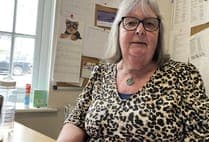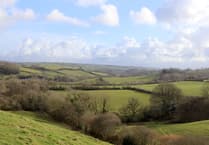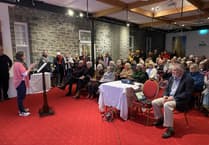Sculptor Andrew Sinclair and his partner Diane Coates, who herself has been sculpting for around seven years, have moved to the area in recent months to open The Sculpture School — a facility where they can run workshops teaching many of the technical and artistic skills behind sculpting.
The couple used to run a studio in Wendover, in the heart of the Chilterns in Buckinghamshire. With the proposed high speed HS2 trains from London planned to run straight through that property, they made the decision to move as quickly as possible.
After it proved impossible to find a property in Buckinghamshire that fitted both their needs and price range, they cast their net further afield, before finding their new home on the North Tawton to Winkleigh road.
One of the property's old poultry barns has now been converted into their sculpture studio, hosting workshops and classes on the art form, as well as offering Andrew a place to continue creating his own sculptures.
It's a far cry from the world of TV and film with which Andrew is familiar — he has sculpted busts for lyricist Tim Rice and actor Colin Baker and been endorsed by the founder of Millennium FX. The company is Europe's leading supplier of prosthetics and special effects for the film and TV industry.
Andrew started out as a furniture maker in London, running a business with a friend making bespoke furniture in the early 1980s. After the company went bust, he took up a job as a dispatch rider, but while on his bike one day, he decided to become a portrait sculptor. He made the decision having taken a class on sculpting when he was 16.
Following a serious motorcycle accident, Andrew received compensation which he used to build a studio in his garden. Twenty five years later, he has not looked back.
He worked for a sculpture company for seven years, crediting that time as his 'apprenticeship' that taught him valuable technical skills before taking the leap to run his own business.
Andrew said: 'Sculpture is a hugely technical business. There's not just the sculpture but the armature making, the scaling up, the moulding, the casting, all the ancillary stuff that goes with it. The melding, the metalwork, the installation, the casting in bronze as well. I've done all of that. It was an accumulation of skills. I am self taught, because there is nobody to teach you those skills!
'Leonardo da Vinci described it as working with mud.
'You either are a painter who sees colour and form in terms of perspective, or you're fascinated like I am with the mud texture itself, the clay and the lack of perspective. There's no perspective in sculpture at all.
'You're literally interpreting what you see and that's what makes it fascinating to me.
'Oddly, when I look back, even when I was a child, I was making things out of plasticine and I saw clay as something really special.
'Plasticine was for children, clay was for grown ups and that's what I wanted.
'I'm still working with clay and I still love the medium.
'There's nothing in my repertoire that beats that. I don't like plaster, I don't like anything else, it's got to be clay.
'It's been a lifelong love. It's like a lot of things in life — you look back in retrospect and you think, oh yeah, I was already showing signs of it then.'
During his career, Andrew has struck up a number of notable relationships, particularly with poet and publisher Felix Dennis.
He created a number of sculptures, including a ten feet tall automaton of King Kong and a life-size statue of Durer's rhinoceros for Dennis's 'Garden of Heroes and Villains', which contained works based on historical, literacy and cinematic characters that he loved and inspired him.
He also sculpted a memorial sculpture commissioned by Dennis himself before his death of terminal throat cancer in June 2014.
Andrew was one of only three people to know about Dennis's illness due to his business interests.
Andrew's memorial sculpture now stands in the Heart of England Forest in memory of Dennis.
His 20ft tall surreal sculpture 'Pre Hysteric', of a naked fat woman riding a dinosaur, graced the Chelsea Flower Show in its centenary year.
Despite having been involved in sculpture for around a quarter of a century, it was only relatively recently that Andrew decided to teach prospective sculptors about the art form.
He found it difficult to get work wth his portrait sculpture work following the global recession of 2008.
'When you're in a recession, people are more concerned about eating than they are about buying sculpture. You are actually in contention with food and you're never going to win that.
'I decided we needed something else for an income. Teaching seemed to be the obvious route to go.
'I found oddly enough, that though I really hated the thought at the time, I've since found I love teaching.
'I love dealing with people.
'It's easy compared with making sculpture which is very difficult and strenuous.
'You find yourself on your back underneath something with rubber dripping in your face or something like that.
'It's been a good financial move but also a lovely move in terms of quality of life. We've made loads of friends.'
Teaching has had an unexpected effect on Andrew's own sculpting.
'The trouble with sculpture is you're trying to teach talent. You're trying to teach something that is innate, or something that people see as innate.
'You've got to find a way to explain it that is very easy to understand.
'It's fascinated me how to get across to students very difficult, esoteric ideas that you seem to either know or don't know.
'I listen to their feedback, I listen to what they tell me and I then change my teaching techniques continuously to make the work more efficient.
'From my point of view it's benefitted me massively.
'My sculpture has just improved hugely. My understanding of it has.
'For example, look at a sculpture of a person — everything about it is based on design.
'What makes him human and all the folds in his clothes are the very last things you put on.
'The design has to come first. Most sculptors are forgetting that these days. They go for the detail over design. It's always an error.'
The couple have described their journey down into Devon as a 'strange dream', but one that has worked out well so far.
Andrew's partner Diane said: 'It's been amazing. We are blown away by it, actually.
'Everyone is so friendly – it's things like people in the supermarket going out of their way to help you. It's such a surprise, coming from the London environs where people are so busy.
'We're driving into Okehampton or Exeter, looking around at the scenery, going "We actually live here, isn't this amazing!"
'We really love it.'




